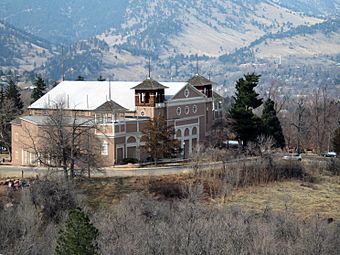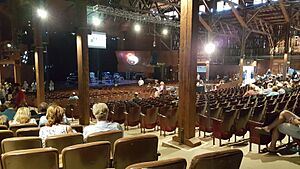Chautauqua Auditorium (Boulder, Colorado) facts for kids
Quick facts for kids |
|
|
Chautauqua Auditorium
|
|

The Chautauqua Auditorium
|
|
| Location | Boulder, Colorado |
|---|---|
| Built | 1898 |
| Architect | F.E. Kidder and E.R. Rice |
| NRHP reference No. | 74000562 |
| Added to NRHP | January 21, 1974 |
The Chautauqua Auditorium is a special wooden building. It was built in 1898 for the very first season of the Colorado Chautauqua. Over the years, it has hosted many interesting events. People have enjoyed lectures, musical shows, and movies there.
This historic building is located at the Colorado Chautauqua in Boulder, Colorado. It was added to the National Register of Historic Places in 1978. At that time, it looked almost exactly as it did when it opened on July 4, 1898.
Contents
History of the Auditorium
Building and Fixing the Auditorium
Work on the Chautauqua Auditorium began on May 12, 1898. It was finished just in time for the first Chautauqua season. This started on July 4, 1898. The building was made of wood. It had dirt floors covered with sawdust. The seats were simple pine benches.
In 1918, the middle part of the dirt floor was changed to concrete. At the same time, some of the old pine benches were replaced. They put in 586 "opera chairs" which were more comfortable.
By the 1970s, the building was getting old and worn out. It was around this time that it became a historic place. Also, the Colorado Music Festival decided to make the Auditorium its main home. These two things helped get the building fixed up. Broken seats were replaced, and the roof was repaired. Loose boards were reattached or replaced. Even with these fixes, the building's original design stayed the same. The amazing sound quality of this wooden building also remained just as it was.
Today, you can still see daylight through small cracks in the Auditorium's walls. But you can no longer see the Moon or stars through the roof!
Famous Early Speakers
Many important people gave speeches at the Auditorium.
- Henry Watterson from Kentucky spoke on opening day, July 4, 1898.
- William Jennings Bryan first visited on July 12, 1899. He came back in 1905 with evangelist Samuel Porter Jones.
- In 1900, speakers from both the Republican and Democratic parties visited. They gave speeches for their presidential candidates. Jonathan P. Dolliver spoke on August 20, 1900. Champ Clark spoke the next week.
- Senators Robert M. La Follette and Benjamin Tillman appeared in 1907.
- The famous speaker Billy Sunday talked to large crowds. He visited the Auditorium in 1909, 1924, 1925, and 1931.
Great Early Music Shows
The Auditorium also hosted many wonderful musical performances.
- The Kansas City Orchestra played many evening concerts in 1898. This was the first year.
- Louis Richar's Band from Chicago played concerts every year from 1903 to 1906.
- John Philip Sousa and his band performed in the fall of 1904. This was after the Chautauqua season ended.
- In 1910, the Chicago Operatic Company presented "costumed recitals from grand opera." This was on July 4.
- The Williams Jubilee Singers were called "the best troupe of colored singers in the world." They gave very popular shows every year from 1911 to 1917. They returned in 1922, 1924, 1926, and 1931.
- Madame Marie Rappold from the Metropolitan Opera in New York City drew the biggest crowd in 1917.
- Miss Frances Ingram, an opera singer, was very popular in 1917 and 1920.
- Ernest Davis, a singer from the Boston Grand Opera Company, performed in 1920.
- Alberto Salvi, known as "the world's greatest harpist," performed every year from 1926 to 1932, except for 1929.
Movies at the Chautauqua
The Auditorium was mainly for talks, music, and live shows. But it also showed motion pictures from the very beginning. In 1898, the film industry was just starting. On July 21, 1898, the Chautauqua program featured "Edison's Genuine Projectoscope." This showed scenes from the war with Spain. The person showing the movie brought their own equipment. This continued until 1918.
From the start, two or three movies were shown each year. The 1913 season was special. It was the first time the Edison Kinetophone was used in Boulder. This was an early attempt to show movies with sound.
In 1918, the Chautauqua Auditorium got its own movie projector. This was for silent films. The movie industry had grown, so it made sense to buy the equipment. Also in 1918, the number of movies shown greatly increased. The Chautauqua did not have enough money to show brand new movies. So, they chose older, family-friendly films.
"Talkies" (movies with sound) started in 1926. All-talking pictures began in 1929. The Colorado Chautauqua was a little behind. This was because they showed older movies. The Auditorium updated its equipment for these new sound films. More and more movies were shown each summer.
The projection equipment was updated again in 1937. This was when Technicolor movies started to appear. In 1948, a new movie screen was put in. It was twice as big as the old one. The new screen measured about 16.5 feet by 22 feet.
By the early 1970s, the movie equipment was very old. It was upgraded in 1979. This made the movie-watching experience much better. However, with home VCRs becoming popular, the family films stopped in 1995.
As of today, the only movies shown at the Colorado Chautauqua are the silent film series. This series started in 1986.
Amazing Sound Quality
Even in its first season in 1898, people praised the Auditorium's sound. The all-wood building's acoustics were compared to places like the Mormon Tabernacle in Salt Lake City. Over the years, many performers loved how their music sounded there. In 1977, Giora Bernstein chose the Chautauqua Auditorium for the Colorado Music Festival. He loved the way sound echoed in the wooden building. This was true even when the building needed repairs.
Singer Michelle Shocked once described the wooden inside of the building. She said, "Now I know what my pick feels like when it falls in my guitar." This shows how special the wood makes the sound.
See also
 In Spanish: Auditorio de Chautauqua para niños
In Spanish: Auditorio de Chautauqua para niños


